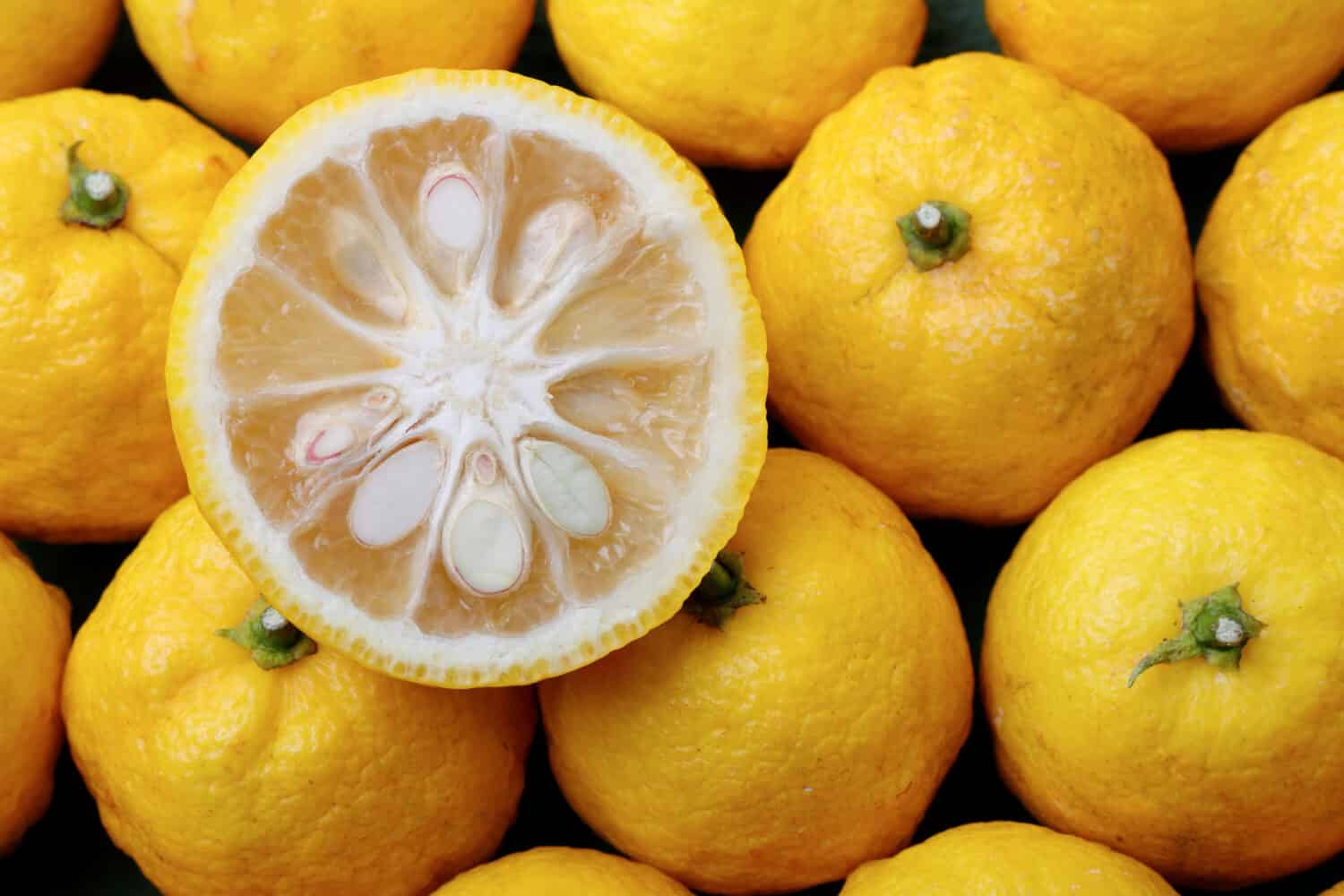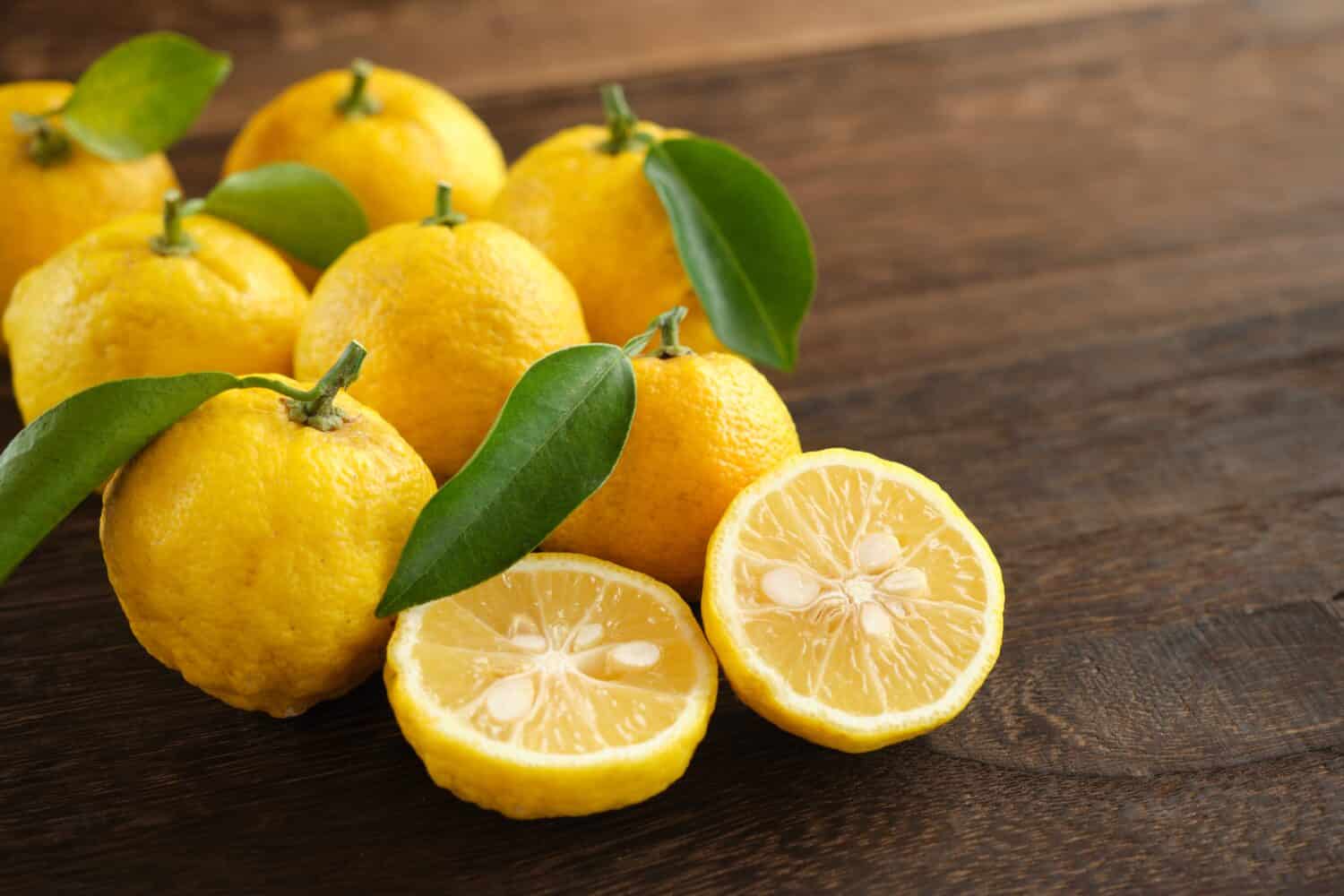Have you ever seen a recipe that has yuzu as an ingredient? Or maybe you've seen it included in cocktails at your latest happy hour. If so, you may wonder what it is and where to find it. From mixed drinks to zesting, this fruit continues to grow in popularity across the U.S., though it's not as well known and can be challenging to locate at your local grocery store.
So what is this fruit, anyway? As a member of the citrus fruit family, yuzu looks like a lemon but packs a punch of vitamin C similar to oranges and grapefruit. Its distinct flavor, however, is unlike lemons or any other fruit.
From taste to how to cook with this unique fruit, here's everything you need to know about yuzu. Let's dive in!
What is Yuzu?
Primarily grown in East Asia, yuzu is a cross between a mandarin orange and another unique citris fruit called ichang papeda. While yuzu is a native of China, it's used frequently in Japanese and Korean cuisine.
The fruit is known for its loose and bumpy skin. Unripe, yuzu is green but turns to a bright yellow (similar to lemon) as it ripens. The inside flesh is also similar to a lemon, with many seeds. This makes the fruit used primarily for its rind zest and juice. Additionally, a fully grown yuzu is about the size of your fist.
According to the Britannica encyclopedia, the U.S. Department of Agriculture has banned the import of this fruit to the United States. However, small batches are grown domestically, mostly in California. This fruit is also difficult to harvest as it grows in thorny bushes.
Due to its low supply and level of difficulty to harvest, yuzu can be rather expensive, if you find it at your local grocery store at all.
Types of Yuzu
Like many fruits, yuzu comes in different varieties. A few common types include:
- Hana Yuzu: Also sometimes called hanayu, this type is used primarily for its flowers and floral fragrance.
- Yukou: A crossbreed between different yuzu fruit, this variety has a less bumpy outer peel and a milder flavor.
- Shishi yuzu: Translated to “lion yuzu” for its large size, some classify it as a pomelo instead of a yuzu.
How Does the Taste of Yuzu Compare to Lemon?
While yuzu looks similar to a lemon, its flavor is more unique. Some describe it as a cross between a mandarin and a lemon flavor, offering the sweetness of an orange, but the tartness of the lemon. Some also feel that the flavor compares more similarly to a grapefruit and it's also been described as having notes of honeysuckle.
Yuzu is also unique in that it has hints of floral in both its scent and taste when ripe. Its tart flavor doesn't make it a great fruit to eat alone in sections. For this reason, yuzu is used mostly for its zest in custards and desserts, as well as its juice for cocktails and other drinks.

©kun7/Shutterstock.com
How to Prepare and Use Yuzu
Yuzu is prepared and used similarly to lemons and limes. This fruit is unique in that it can also be used at any stage of ripeness. While still green and underripe, yuzu is used for its zest and as a garnish. When fully ripened, its juice can be used in recipes. While extremely versatile, yuzu's tart flavor requires it to be juiced or zested before adding it to any recipe.
Its flavor is perfect for cocktails and balances out boozy flavoring. In fact, this fruit continues to grow in popularity in the mixed drink scene. You can also offset the fruit's tart flavoring by combining it with sugar. Yuzu is often used in desserts like ice cream and pie.
Additionally, this fruit's versatility allows it to be used in various ways in Japanese culture. In the kitchen, you'll likely see it as an addition to tea, soup, or baked goods. Outside the kitchen, yuzu is used in skincare products, perfumes, or as an addition to a relaxing bath.
When purchasing fresh yuzu, you can place it on the counter at room temperature if you plan to use it within the next few days. Otherwise, you can place the fruit in your refrigerator to help extend it's shelf life.
Where to Purchase Yuzu
As mentioned, yuzu can be challenging to find locally. Most of the fruit is grown outside the country and isn't allowed to be transported and sold within the United States. However, some growers in California produce fresh fruit, making it possible to find it when it's in season.
Unripe green yuzu can be found in August through October at farmer's markets or specialty grocery stores. Fully ripened and yellow yuzu can be found in September through December.
If you're looking for fresh yuzu, your local Asian market may be your best bet when locating the fruit. However, the juice can also be bottled and sold year-round. You can find bottled juice available to purchase online.
Yuzu Recipes
When looking for yuzu recipes, you can find many recipes online. Here are a few ideas to try:
- A marinade for meat or fish made with yuzu.
- Cocktails like a yuzu margarita. In cocktails, the juice can be combined with the drink, or you can use a slice or peel for garnish.
- As a light and citrusy flavor in desserts such as tiramisu, cakes, custards, or sorbet.
You can also use yuzu in place of lemon or orange juice. Keep in mind that the flavors aren't exactly the same, however, so you may not want to use yuzu as an exact 1:1 ratio.

©fayfena/Shutterstock.com
Health Benefits of Yuzu
Yuzu is a vibrant citrus fruit that's well-known for its health benefits. From its high levels of vitamin C (59% of your daily value!) to fiber, minerals, and antioxidants, yuzu and its juice can be part of a healthy diet.
Healthline reports a few benefits of consuming yuzu including:
- Improved blood flow from key flavonoids found in the pulp and peel.
- Better immune health due to the high level of vitamin C.
- A healthy gut from high levels of fiber.
- Possible improvement of brain and heart health.
- Possible reduction of stress.
While more studies need to be conducted to determine the full health effects of yuzu, many choose to consume fresh fruit or purchase it in essential oil form to reap all of its positive properties.
Additionally, while it can be challenging to find fresh fruit locally in the United States, you can reap the full benefits by purchasing bottled yuzu juice. Just be sure to look for a product that's 100% fruit juice and free of any additives. Many companies add sugar to the juice to offset the tartness of yuzu. Always be sure to read the label before purchasing.
Final Thoughts
Yuzu is a yellow citrus fruit found in Southeast Asia that looks similar to a lemon. Its taste, however, is more unique and includes a combination of citrus, floral, and sweet flavors. While this fruit can be challenging to find stateside, you can check your local Asian markets for a fresh option, or purchase bottled juice online or in specialty stores.
However you choose to consume or use yuzu, you can reap some pretty amazing health benefits, too! Now, the next time you see or hear about yuzu, you'll have a full understanding of what it is, how it's used, and how it can be beneficial to your diet. Enjoy!
Recipe Card
Print
Citrusy Yuzu Salmon Poke Bowl
Ingredients
- 1 lb fresh sushi-grade salmon, cubed
- 1/4 cup soy sauce
- 2 tablespoons yuzu juice
- 1 tablespoon sesame oil
- 1 tablespoon honey
- 1 teaspoon grated fresh ginger
- 2 cups cooked sushi rice, cooled
- 1 avocado, sliced
- 1 cucumber, julienned
- 1 carrot, shredded
- 1 cup edamame, steamed
- 2 tablespoons sliced green onions
- 1 tablespoon sesame seeds
- Nori strips for garnish
Instructions
- In a bowl, whisk together soy sauce, yuzu juice, sesame oil, honey, and grated ginger to create the marinade.
- Add the cubed salmon to the marinade, ensuring it's well-coated. Refrigerate for at least 15 minutes.
- Assemble the poke bowls by dividing the sushi rice among serving bowls.
- Top the rice with marinated salmon, sliced avocado, julienned cucumber, shredded carrot, and steamed edamame.
- Garnish with sliced green onions, sesame seeds, and nori strips.
- Drizzle any remaining marinade over the poke bowls.
- Serve immediately and enjoy the refreshing flavors of yuzu in this delightful salmon poke bowl.
The image featured at the top of this post is ©manbo-photo/Shutterstock.com.

